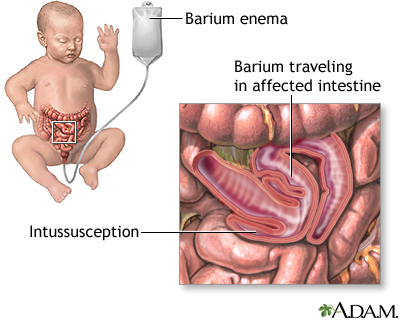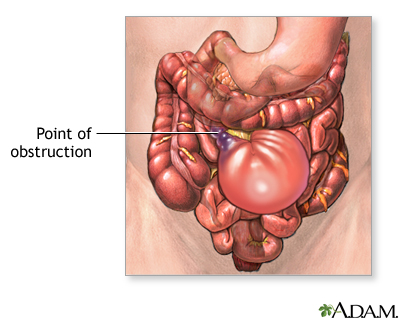Intestinal obstruction repair
Repair of volvulus; Intestinal volvulus - repair; Bowel obstruction - repair
Intestinal obstruction repair is surgery to relieve a bowel obstruction . A bowel obstruction occurs when the contents of the intestines cannot pass through and exit the body. A complete obstruction is a surgical emergency.
Bowel obstruction
Intestinal obstruction is a partial or complete blockage of the bowel. The contents of the intestine cannot pass through it.

Description
Intestinal obstruction repair is done while you are under general anesthesia . This means you are asleep and DO NOT feel pain.
General anesthesia
General anesthesia is treatment with certain medicines that puts you into a deep sleep so you do not feel pain during surgery. After you receive the...
The surgeon makes a cut in your belly to see your intestines. Sometimes, the surgery can be done using a laparoscope, which means smaller cuts are used.
The surgeon locates the area of your intestine (bowel) that is blocked and unblocks it.
Any damaged parts of your bowel will be repaired or removed. This procedure is called bowel resection . If a section is removed, the healthy ends will be reconnected with stitches or staples. Sometimes, when part of the intestine is removed, the ends cannot be reconnected. If this happens, the surgeon will bring one end out through an opening in the abdominal wall. This may be done using a colostomy , ileostomy , or mucous fistula.
Bowel resection
Large bowel resection is surgery to remove all or part of your large bowel. This surgery is also called colectomy. The large bowel is also called t...

Colostomy
Colostomy is a surgical procedure that brings one end of the large intestine out through an opening (stoma) made in the abdominal wall. Stools movin...

Ileostomy
An ileostomy is used to move waste out of the body. This surgery is done when the colon or rectum is not working properly. The word "ileostomy" come...
Why the Procedure is Performed
This procedure is done to relieve a blockage in your intestine. A blockage that lasts for a long time can reduce or block blood flow to the area. This can cause the bowel to die.
Risks
Risks of anesthesia and surgery in general include:
- Reactions to medicines, breathing problems
- Bleeding, blood clots, infection
Risks of this procedure:
- Bowel obstruction after surgery
- Damage to nearby organs in the body
-
Formation of scar tissue (
adhesions
)
Adhesions
Adhesions are bands of scar-like tissue that form between two surfaces inside the body and cause them to stick together.
 ImageRead Article Now Book Mark Article
ImageRead Article Now Book Mark Article - More scar tissue forming in your belly and causing a blockage of your intestines in the future
- Opening of the edges of your intestines that are sewn together (anastomotic leak), which may cause life-threatening problems
- Problems with colostomy or ileostomy
-
Temporary
paralysis
(freezing up) of the bowel (
paralytic ileus
)
Paralysis
Muscle function loss is when a muscle does not work or move normally. The medical term for complete loss of muscle function is paralysis.
Read Article Now Book Mark ArticleParalytic ileus
Intestinal obstruction is a partial or complete blockage of the bowel. The contents of the intestine cannot pass through it.
 ImageRead Article Now Book Mark Article
ImageRead Article Now Book Mark Article
After the Procedure
How long it takes to recover depends on your overall health and the type of operation.
Outlook (Prognosis)
The outcome is usually good if the obstruction is treated before bowel blood flow is affected.
People who have had many abdominal surgeries may form scar tissue. They are more likely to have bowel obstructions in the future.
References
Boniface K. Bowel obstructions. In: Adams JG, ed. Emergency Medicine: Clinical Essentials . 2nd ed. Philadelphia, PA: Elsevier Saunders; 2013:chap 40.
Fry RD, Mahmoud NN, Maron DJ, Bleier JIS. Colon and rectum. In: Townsend CM, Beauchamp RD, Evers BM, Mattox KL, eds. Sabiston Textbook of Surgery . 19th ed. Philadelphia, PA: Elsevier Saunders; 2012:chap 52.
Mizell JS, Turnage RH. Intestinal obstruction. In: Feldman M, Friedman LS, Brandt LJ, eds. Sleisenger and Fordtran's Gastrointestinal and Liver Disease: Pathophysiology/Diagnosis/Management . 10th ed. Philadelphia, PA: Elsevier Saunders; 2016:chap 123.
-
Intussusception - X-ray - illustration
This abdominal x-ray shows an intestinal condition in which a loop of bowel has slipped into another section of bowel (intussusception), causing swelling, reduced blood flow, obstruction, and tissue damage. Intussusception requires emergency treatment (barium enema or surgery) to prevent intestinal tissue death (necrosis), intestinal perforation, peritonitis, and death.
Intussusception - X-ray
illustration
-
Before and after small intestine anastomosis - illustration
A patient's recovery depends on the cause of the intestinal obstruction and the length of time prior to relief of the obstruction. The outcome is usually good if the obstruction is treated before damage (ischemia) or death (necrosis) of the bowel occurs.
Before and after small intestine anastomosis
illustration
-
Intestinal obstruction (Pediatric) - series
Presentation
-
Intestinal obstruction repair - series
Presentation
-
Intussusception - X-ray - illustration
This abdominal x-ray shows an intestinal condition in which a loop of bowel has slipped into another section of bowel (intussusception), causing swelling, reduced blood flow, obstruction, and tissue damage. Intussusception requires emergency treatment (barium enema or surgery) to prevent intestinal tissue death (necrosis), intestinal perforation, peritonitis, and death.
Intussusception - X-ray
illustration
-
Before and after small intestine anastomosis - illustration
A patient's recovery depends on the cause of the intestinal obstruction and the length of time prior to relief of the obstruction. The outcome is usually good if the obstruction is treated before damage (ischemia) or death (necrosis) of the bowel occurs.
Before and after small intestine anastomosis
illustration
-
Intestinal obstruction (Pediatric) - series
Presentation
-
Intestinal obstruction repair - series
Presentation
Review Date: 2/27/2016
Reviewed By: Debra G. Wechter, MD, FACS, general surgery practice specializing in breast cancer, Virginia Mason Medical Center, Seattle, WA. Also reviewed by David Zieve, MD, MHA, Isla Ogilvie, PhD, and the A.D.A.M. Editorial team.














